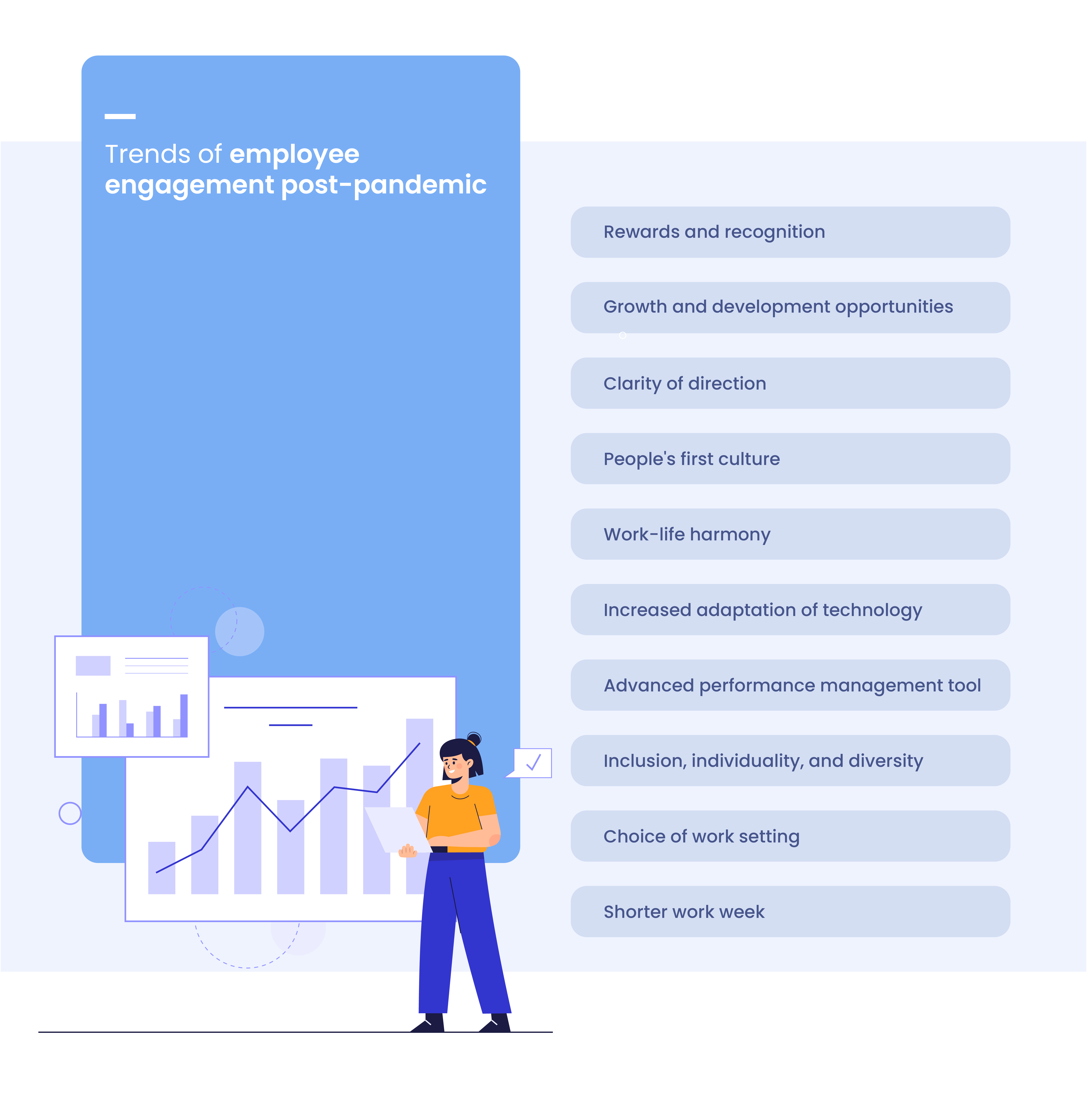Introduction
The pandemic not only generated a wave of economic catastrophe and digital transformation but also had a profound effect on the global population’s thought process. The new ways of living directly influenced the new ways of working. Between global layoffs and the Great Resignation, the recruitment business faced a level of a scramble, in which employers and employees required each other more than ever.
This distress also triggered a shift in employees’ perceptions of the employers. People were reconsidering their personal beliefs and expectations and their professional commitments. Work-life balance, flexible working hours, and employee-friendly policies were no longer optional. They became vital, and employees left their positions searching for more willing companies.
One of the most significant long-term implications of working in the pandemic is the present emphasis on developing sustained employee engagement that meets the changing employee expectations.
This blog will take you through how the pandemic flipped employee expectations from the company, and how HRs can meet the new employee expectations.

Employee Engagement definition before the pandemic
In the pre-pandemic work culture, employee engagement strategies were based on annual employee surveys, while employee expectations from organizations were limited to fairly attractive salary packages and benefits and sets of casual leaves per year.
Employee Engagement definition after the pandemic
The after-effects of Covid 19 are not missing from the post-pandemic scenes. The necessary remote working model became quite popular and served as a learning curve for managers. Corporates realized that boosting employee engagement and accommodating employee expectations from the company is key to retaining the best talents.
Employee engagement in the post-pandemic world is no longer limited to a hefty paycheck. It includes better work-life balance, a supportive work culture, increased technology adaptation, growth opportunities, and skill development.
What are the top trends of employee engagement post-pandemic?

The traditional employee engagement methods primarily involved conducting annual employee surveys, ad-hoc surveys, employee focus groups, etc. But with the onset of the pandemic, companies started facing a dent in the talent pool and realized that the age-old engagement methods would not work anymore.
Now, employees expect more than a bulky paycheck. So, to keep up with the post-pandemic norms and fix the pain points, a company needs to understand the multifaceted shift in employee engagement trends.
Here is a list of employee expectations that are most prevalent in the post-pandemic scenario:
1. Rewards and recognition
Feeling valued and recognized for their work is one of employee engagement’s primary and most consistent drivers. While it was relevant even in the pre-pandemic world, the workforce’s approach towards it has evolved.
According to a recent survey, recognition for their work is the most crucial part for 37% of employees. An SHRM report found that 91% of HR professionals believe that employee retention can be significantly increased with a proper employee recognition program.
The isolation and disconnection during the pandemic increased the need to feel recognized. The new generation of workers is not willing to settle for only benefits, making recognition one of the primary examples of employee expectations. Recognizing their efforts incentivizes them to be more productive, engaged, and driven in their job roles. Every employee is different, and so are their aspirations. So to improve employee engagement, employee recognition strategies need to be holistic, agile, and personalized.
2. Growth and development opportunities
The last couple of years has allowed the global workforce to evaluate their career aspirations. They have upskilled their qualification and naturally want more when it comes to their career. Talented individuals seek to be a part of organizations that offer a defined and visible path for career progression.
Evidently, it is essential for organizations to understand that when it comes to growth, employee expectations from the company don’t only include promotions. Companies need to foster an environment of continuous learning and development for employees. Organizations must put effort into identifying every employee’s defining skills and providing them with proper learning opportunities. Companies that invest in the growth of their employees are successful in engaging and thus retaining employees and decreasing their attrition rates.
3. Clarity of direction
Amid other significant changes, employees want to understand the proper expectations from their job positions and how their work impacts other departments and the company. Now, one of the most prominent examples of employee expectations is a clear future outlook of the company in general.
Integrating change and communicating a clear sense of direction was challenging in the pre-pandemic remote and hybrid work environment. That is why senior leadership and management must have a proper strategy to communicate a comprehensive vision for the company’s future. Here are some of the points to keep in mind –
- Interdepartmental synergy and transparency
- Encouraging new and innovative ideas
- Make timely decisions and communicate them to your employees
- Alignment of their work with the company’s goals for the future
- Transparency regarding the organization’s current health and future direction
4. People’s first culture
The isolation during the pandemic has allowed people to prioritize certain aspects of their life – personal space being one of the most important ones. So, a positive and flourishing work culture became an important driver of employee expectations. There is now a growing need to develop a harmonious and employee-oriented culture. Introducing people first policies will help develop in them a feeling of care and respect for the organization.
In the post-pandemic era, employee well-being has become one of the prominent drivers of employee engagement. While flexible timing and remote working were more of a need during the pandemic, the current trends show that it is time to make such a work model a permanent part of the corporate culture.
An employee-oriented work culture builds trust among employees in the company. Some of the initiatives which can be taken for a people-first approach are –
- Flexible work schedules
- Providing adequate resources for task completion
- Listening to their needs and issues and addressing them promptly
5. Work-life harmony
In the pre-pandemic world, overworking had become the norm. The separation of work and private life was a challenge that most active workers faced and expected to accept. This led to burnout and severe exhaustion.
But in the post-pandemic work culture, employees expect a healthy work-life balance from their employer. According to a survey by Statista, 72% of people looking for a job consider work-life balance to be an essential factor to consider.
To allow a healthy harmony between professional and personal life, it is crucial to invest serious focus on assigning manageable work goals, flexible schedules, and a permanent remote working model. It gives them more autonomy, and more time to invest in personal commitments and still get work done through their most productive hours.
6. Increased adaptation of technology
Increased technology adaptation is most visible among the massive changes in the post-pandemic workforce management landscape. To fill in the increased skill gap due to mass attrition, manually handling recruitment, onboarding, and other HR functions are not sustainable anymore. Therefore, to conduct bulk recruitments and make the whole process of employee administration seamless, the rising use of technology has emerged in all functions of the HR department.
Employee expectations from the company now include a streamlined onboarding and hassle-free workflow. One of the notable reasons behind the influx of HR software solutions is the increasing number of tech-savvy millennials joining organizations. The global talent pool is accessible now, and leveraging technology was inevitable to connect employees and teams from different corners of the world.
But it would be a mistake to consider it a mere strategy to keep Gen Z engaged. Integrating technology into the HR system saves time and resources and increases the organization’s overall efficiency.
Many leading and scaling companies have invested in the latest AI-powered platforms for better collaboration and performance management during remote working and to keep up with the ‘new normal’.
7. Advanced performance management tool
Be it pre-pandemic or post-pandemic, performance management and appraisal have always been valuable metrics in determining employees’ contributions to organizational performance and their growth within the organization.
But the new age employees are not satisfied with mere annual performance appraisal evaluations. As a result, most organizations now realize that the annual rating system is not feasible anymore.
The current workforce scenario demands companies make their performance management a holistic and frequent process. Modern workplaces need agility in goal management with consistent frequency. A multi-dimensional and feedback-based approach will not only make your employees feel seen but also will get performance management ready for this new age.
A data-driven, real-time, and clear understanding of your employees’ performance growth will act as an incentive for employees to be engaged and to improve.
8. Inclusion, individuality, and diversity
A company’s DE&I strategy has always been one of the crucial drivers of employee engagement. An analysis by Mckinsey states that companies with a more diverse workforce and inclusive work culture tend to be more profitable, more productive, and more competitive, yielding better business results.
However, in the pre-pandemic world, most companies overlooked the diversity aspect while accommodating the employee expectations from their company. But the workforce has evolved, and so has the market. When people from varying gender, orientation, or racial backgrounds come together as a workforce, they bring different perspectives and experiences to the table. Companies can leverage this diversity of thought and approaches as a critical ingredient to foster innovative solutions.
But to accommodate a diverse workforce, strategies need to be inclusive of different backgrounds. External bias needs to be eliminated from the recruitment process and should not be a roadblock to your employee’s growth.
9. Choice of work setting
While some employees now prefer a remote work model, some may depend on specific resources at their office and find the work-from-home setting too distracting to be properly productive.
With the multifaceted impact of the pandemic, workplaces have adapted to a more agile, collaborative, and versatile mode of operations. So totally remote or onsite work may not accommodate every workforce. That’s why several companies are adopting a hybrid work model that caters to the employees the advantages of both remote and traditional work settings.
10. Shorter work week
This trend is driving organizations to rethink their Employee Value Proposition (EVP) with reduced hours. To consider this new EVP approach, top-tier leaders and hiring managers need to work together to review roles and systems that can accommodate a shorter work week. Such an approach will also prevent your employees from experiencing frequent burnout.
Is your organization prepared for the post-pandemic changes?

The pandemic has brought robust changes in the market, making effective talent acquisition and retention challenging to maintain with the traditional employee engagement approach. It not only changed the priorities of employees but also forced organizations to be more employee-oriented.
Pre-COVID employee expectations from organizations usually had a fixed line that included promotions, better pay, and recognition as crucial factors to joining an organization.
The post-pandemic trends, however, highlight remote working, flexible schedules, healthy work-life balance, and streamlined HR operations more prominently. While working from home seemed like a luxury in the past, it is highly likely that it may turn into the normal way of working for most companies post-COVID.
The ways to keep employees engaged have evolved, and organizations must keep up with the list of employee expectations to scale their business and emerge as successful employer brands.
Leena AI’s cutting-edge HR solutions will ease the workload on your HR and bring efficiency, collaboration, and a clear path of improvement in your employee engagement strategy.
So, opt for Leena AI today to be relevant in this rapidly changing corporate world.






